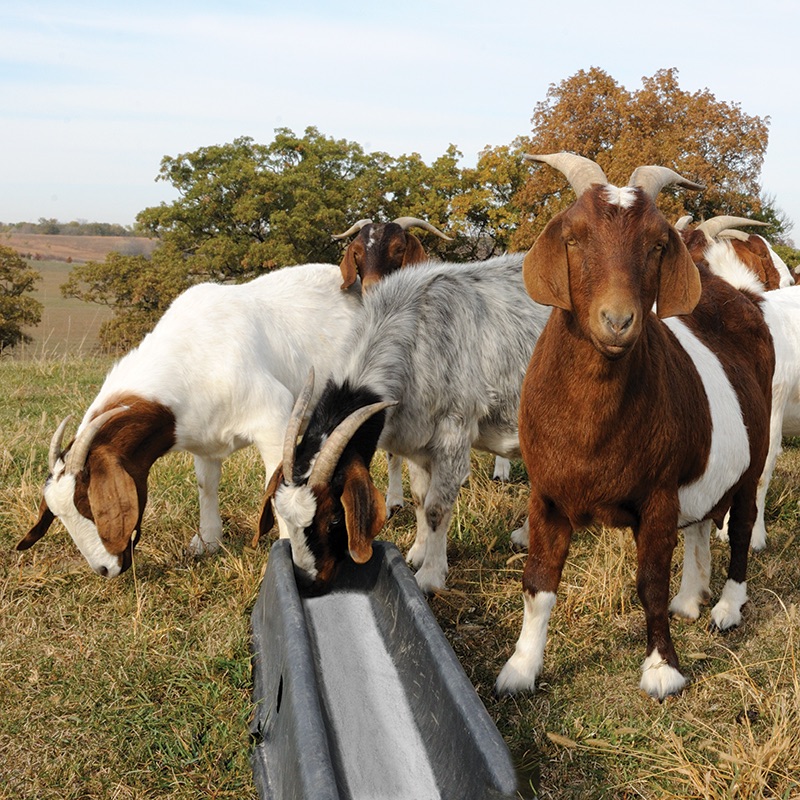Lamb Feeding Basics
By Dan Morrical, Ph.D.
Every sheep producer is concerned about profitability. This can be directly correlated to the number of lambs weaned per ewe. But the “value added” portion of any sheep operation is the finishing of the lamb crop from weaning to market. If the cost of producing additional gain is less than the price of the lamb when sold, we can add net profit for every additional pound produced.
- The first step to successfully finishing the lamb crop is to make sure they have been vaccinated against enterotoxemia with Clostridium perfringens type C and D toxoid. This is an initial vaccination with a booster 2–3 weeks later and ideally ahead of weaning. Premier offers several Clostridial vaccines.
- The next step is to minimize stress during the weaning transition. One approach is to leave the lambs where they were raised and move the ewes to another location. Ideally the ewes should be out of earshot from the lambs.
- Lastly, leave the lambs with their pen mates and on a creep ration to ensure a smooth weaning. One can sort ram lambs from ewe lambs and begin transitioning to the grower ration a week after weaning.
The growing phase of the feed out period lasts for approx. 60 days. Lambs can be fed a ration that is 16% crude protein. In the Midwest, corn is readily available and a cheap source of nutrients. Corn also generates very efficient gains. However, corn can increase the chance of acidosis and/or enterotoxemia. High corn rations also must be fortified with limestone or calcium carbonate to correct the calcium phosphorus ratio which reduces the incidence of urinary calculi. As a result, I now prefer soybean hulls for finishing lambs. They contain less starch than corn, and lambs seem to relish the taste. Soy hulls also have more protein and a better calcium to phosphorus ratio. When combined with dry distillers, they make an extremely economical ration. But lambs fed on hull-based rations will have poorer feed conversions when compared to corn-based rations.

Hand feeding vs. on-demand self-feeders?
Some producers prefer hand feeding lambs daily, while others allow ad lib feed intake. Each has benefits and drawbacks:
- Hand feeding should be done at the same time each day so lambs become accustomed to a schedule.
- More bunk space and labor is typically required with hand feeding.
- Lamb monitoring is harder with self-fed lambs.
- It’s critical that the feed for self-fed lambs never runs empty. Otherwise the lamb is at risk for over-eating once refilled.
- When using a soybean hull ration it’s important that you have an adequate supply. Abruptly switching to corn puts the animals at risk of acidosis.
Clean fresh water is important for successful finishing. Lambs that consume more water will eat more feed and gain faster. An additional benefit of high water intake is that lambs are less likely to develop urinary calculi. Watering devices should be cleaned regularly, even daily if many lambs are using a single water source. Salt and ammonium chloride can help prevent urinary calculi. Both ingredients are added to the ration at .5% or 10 pounds per ton. Many producers offer free choice sodium bicarbonate for lambs. This counteracts the ammonium chloride and its acidification of the urine.
How much hay should I include in the lamb’s diet?
It’s a question we’re often asked via Premier’s FREE Ask An Expert advice service. Some hay or other fiber source is beneficial for the health of the rumen. This is especially important if the ration is pelleted. Hay increases cud chewing that increases saliva production. The saliva contains a buffer which helps maintain rumen pH. But don’t overdo it! Premier typically includes only
- It’s more expensive per pound of nutrients than corn.
- It’s less energy dense and will slow down the rate of gain if included at high levels in the ration.
- Lambs will waste quite a bit when given too much.
Death loss can be very costly during the finishing phase. Lambs are worth a lot and the feed they have consumed must be paid for by the lambs that do make it market. For home-raised lambs, the death loss should be 2% or less.
Besides enterotoxemia, urinary calculi, and acidosis, we can lose lambs to pneumonia, barn cough, prolapses and heat stress. Well-ventilated housing with clean dry bedding can help with all of these problems. Wooled lambs can be shorn to help keep them cool. Bedding can also improve pelt cleanliness and dressing percentage. We have greatly reduced barn cough at Premier by adding extra ventilation with turbo fans blowing directly on the manure pack.
Once lambs have been on feed for 60 days the cost of the ration can be reduced by bringing the protein content down to 13%. This is really important when soybean meal is the protein source. Corn, dry distillers and soybean hulls are all similar in price, so reducing the protein content on soy hull dry distillers does not lower ration costs.
Why and how do you feed trace mineral?
Many forages and feedstuffs throughout the USA lack the proper mineral concentrations for sheep and goats. By offering trace minerals free choice (mixed with salt), or in a ration mixed with feed, shepherds can make up for the lack of naturally occurring mineral. The result? Prevention of deficiencies now means fewer animals requiring treatment later on.
What do mineral deficiencies mean for your sheep flock or goat herd?
Selenium- A deficiency most often appears in the form of white muscle disease (stiff lambs/kids) or those that lack a suckling response. Selenium aids in reproduction, and happens to be an antioxidant (an aid to muscle function).
Iodine- Functions in prevention of goiter and stillbirths. Lack of iodine results in increased risk of hypothermia or starvation in lambs/kids.
Zinc- Improves hoof health, stronger hooves that are better able to resist foot rot. For reproduction and growth. Deficiency results in steely wool (poor fiber formation).
Cobalt- Necessary for energy metabolism and stimulating the animal’s appetite.
Manganese- Deficiency results in slowed growth, potential skeletal deformities, and effects neurological muscle control.
Molybdenum- Only added to sheep rations. Ties up copper to prevent copper toxicity.
Calcium- For bone strength. Balances out phosphorus (Ca:P ratio) which is often high in concentrate feeds.

Small Ruminant Nutritionist
The GOLD Formula difference…
The Shepherd’s Choice® GOLD Formula Premixes have been specifically formulated for small ruminants to maximize health and immunity.
All of Premier’s premixes include the essential trace minerals needed for well-being of sheep and goats. But GOLD Formula Premixes build on the work done by Dr. Kennedy of Pipestone Veterinary Services by increasing the levels of zinc and iodine to promote stronger, healthier hooves.
Why no Vitamins A/D/E in the mix?
Our research determined that when vitamins are added to a premix, they begin to degrade and lose their effectiveness. The shepherd can slow this break down by keeping vitamins and minerals separate, until they are ready to be fed. Make vitamin and mineral batches small, if possible. A small batch should be consumed within one month. Opened packages of Vitamin A/D/E can be stored in the freezer between mixings.


